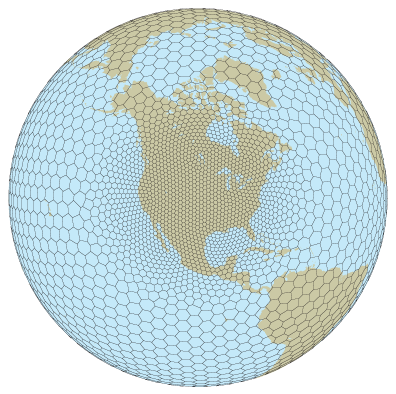MPAS stands for Model for Prediction Across Scales. It is a “collaborative project” for building earth system model components that can be run at multiple scales. MPAS-A is the atmospheric component of MPAS. Often, at least in our circles, “MPAS” means the standalone version of MPAS-A. But it’s important to remember that there are other MPAS component models[1], and MPAS-A has also been used in larger modeling systems, e.g. as the atmosphere component[2] or as the dynamical core only[3].
History¶
Skamarock & Gassmann (2011) Skamarock et al. (2012)
Meshes¶

What makes MPAS special is its use of unstructured Voronoi meshes on the sphere (SCVT), including C-grid staggering.
Horizontal velocity components are defined normal to the cell edges, and vertical velocity is defined at cell vertices.
There is a primal mesh (usually mostly hexagons, as above) that most variables are defined on, and a dual mesh made up of triangles formed by connecting the primal mesh cell centers. In the model outputs, vorticity is an example of a dual mesh variable.
Links¶
- MPAS project website: https://
mpas -dev .github .io/ - MPAS-A landing page: https://
www2 .mmm .ucar .edu /projects /mpas /site /index .html - MPAS mesh spec document: https://
mpas -dev .github .io /files /documents /MPAS -MeshSpec .pdf - MPAS-A tech note (in development): https://
www2 .mmm .ucar .edu /projects /mpas /mpas _website _linked _files /MPAS -A _tech _note .pdf - HTML user guide quick start: https://
www2 .mmm .ucar .edu /projects /mpas /site /documentation /users _guide /quick _start .html - PDF user guide: https://
www2 .mmm .ucar .edu /projects /mpas /mpas _atmosphere _users _guide _8 .3 .0 .pdf - MPAS official virtual tutorial material: https://
www2 .mmm .ucar .edu /projects /mpas /tutorial /Virtual2025/ - WRF/MPAS workshop talks: https://
www .mmm .ucar .edu /events /133265 /agenda (2025)
e.g. MPAS-CMAQ, MPAS-Hydro (in development), NOAA GSL MPAS for smoke and dust, MPAS-GOCART
e.g. in CESM, part of the StormSPEED CSEM/CAM dynamical cores comparison project, and planned for UFS as an alternative to FV3
- Skamarock, W. C., & Gassmann, A. (2011). Conservative Transport Schemes for Spherical Geodesic Grids: High-Order Flux Operators for ODE-Based Time Integration. Monthly Weather Review, 139(9), 2962–2975. 10.1175/mwr-d-10-05056.1
- Skamarock, W. C., Klemp, J. B., Duda, M. G., Fowler, L. D., Park, S.-H., & Ringler, T. D. (2012). A Multiscale Nonhydrostatic Atmospheric Model Using Centroidal Voronoi Tesselations and C-Grid Staggering. Monthly Weather Review, 140(9), 3090–3105. 10.1175/mwr-d-11-00215.1
- Wong, D. C., Willison, J., Pleim, J. E., Sarwar, G., Beidler, J., Bullock, R., Herwehe, J. A., Gilliam, R., Kang, D., Hogrefe, C., Pouliot, G., & Foroutan, H. (2024). Development of the MPAS-CMAQ coupled system (V1.0) for multiscale global air quality modeling. Geoscientific Model Development, 17(21), 7855–7866. 10.5194/gmd-17-7855-2024